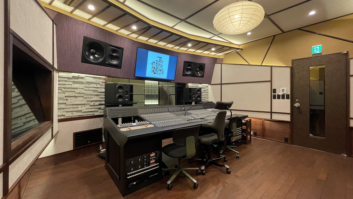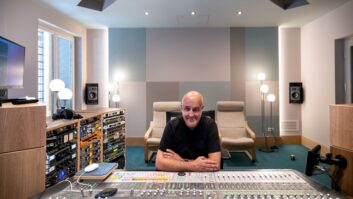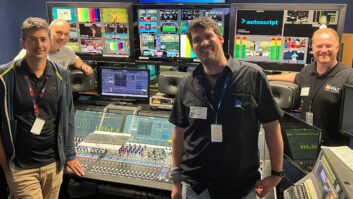Native Instruments Solid Mix Series plug-insWhat’s old is new again in the world of plug-ins, as software developers continue to search the vintage equipment racks for popular classic gear to emulate. The steady stream of new plug-in releases has become something of a constant in the pro audio industry, with recent introductions ranging from models of analog tape machine to digital reverb via classic outboard and in-console processing.

Waves Audio (waves.com) recently released its MPX Master Tape plugin, an emulation of the final link in renowned recording engineer Eddie Kramer’s signal chain from Olympic Studios during the 1960s. The MPX plug-in is the latest in an ongoing series of collaborations between Waves and Kramer. Previous releases include the HLS Channel (modeled on a Helios console input module) and PIE Compressor (which was modeled on the solid-state unit manufactured by Pye Telecom).
Universal Audio Lexicon 224 digital
reverb plug-inDeveloped in association with Kramer, MPX is modeled on a rare reel-to-reel machine incorporating an Ampex 350 transport with model 351 valve-based electronics. The particular machine on which the MPX plug-in was modeled is owned by veteran mixer/ engineer Eric Schilling; 3M Scotch 206/207 tape reportedly proved to be an ideal match for the machine.

Controls include adjustable tape speed, bias, flux, and wow and flutter, along with noise parameters. In a nod to contemporary production methods, Waves has added some more modern features, most notably a flexible slap and feedback delay that is suitable for rock, dance, dub and other styles.
The Waves MPX Master Tape plug-in is available in native and TDM versions, and is available at no additional charge to owners of Waves Mercury with current Waves Update Plan coverage.
Waves has also teamed up with another legend, Abbey Road Studios (abbeyroadplugins.com), for a firsttime collaboration on a plug-in modeled after the historic microphones used by British royalty in the events that inspired the 2011 Best Picture Oscar-winner, The King’s Speech. Waves notes that the plug-in is the only product of its kind that re-creates these rare microphones.
Peter Cobbin, senior recording engineer at Abbey Road Studios, worked with Waves after having had the opportunity to use the original microphones, during the recording of the score for The King’s Speech. The mics were originally built and precisely tuned by EMI (appropriately, the owner of Abbey Road Studios) for specific members of the Royal Family—King George V, King George VI and Queen Elizabeth II—in the 1920s and ’30s.
Waves Audio MPX Master Tape plug-inThe King’s Microphones plug-in is a special EQ filter processor that re-creates the unique tonal character of those microphones, which were based on the Marconi-Reisz carbon microphone, circa 1925, and EMI’s CPM201 model moving coil mic. Three proximity positions are provided for each: Close, Ambient and Natural. The plug-in is available in RTAS, AudioSuite, VST, AU and Waves Sound- Grid formats, and works in mono or stereo mode.

Although vintage analog equipment offers a rich vein for plug-in developers to mine, emulations of pieces from the early days of digital have also found their way onto the market. One case in point is Universal Audio’s (uaudio.com) officially sanctioned release of the iconic Lexicon 224 digital reverb. The device became a staple in many studios worldwide following its introduction in 1978 and arguably ushered in the modern era of quality digital ’verb.
Designed for Universal’s UAD- 2 platform, the Lexicon 224 plug-in captures all eight reverb programs available in the original’s version 4.4 firmware, including every tunable parameter, with unique fader-style controls modeled after the original hardware remote. The emulation captures the entire analog and digital signal path of the original unit, from the input transformers to those early-generation converters.
UA’s 224 plug-in was developed in collaboration with several notable users, and also includes some of their presets. Those involved included Chuck Zwicky (Prince, Jeff Beck), Eli Janney (Jet, Ryan Adams), David Isaac (Eric Clapton, Luther Vandross), E.T. Thorngren (Talking Heads, Bob Marley) and Kevin Killen (U2, Peter Gabriel).
On the subject of collaborations, Native Instruments (native-instruments.com) has teamed up with Swedish developer Softube (softube.se), which has launched several Tube-Tech emulations— among other releases—over recent years, for a bundle entitled Vintage Compressors. The package, the first in a planned new series of professional studio effects, works within NI’s free Guitar Rig 4 Player and Guitar Rig 4 Pro.
The three compressors, modeled after some of the most popular vintage units, are the VC 76, VC 2A and VC 160 (making it a simple matter to guess which brands and models they emulate). Each is also available separately. In addition to the unmistakable sounds and strengths of the originals, the plug-ins also offer modern control options in the form of side-chaining and parallel (wet/dry) compression features.
The VC 76 is intended as a workhorse compressor with a fast attack, with reportedly great presence, and punchy, clear high end suitable for drums, vocals or stereo limiting. The VC 2A is a smooth compressor with a silky, natural sound, for vocals, bass, pads and guitar. Last but not least, the VC 160 offers added attack and a subtle drive and is described by the company as especially good on kick drum, snare, bass or guitar.
In another nod to modern productions, both the VC 160 and the VC 2A feature an additional Low-Cut dial that sets the lowest frequency at which compression occurs. The control prevents over-compression caused by heavy low-frequency impulses.
Native Instruments is already expanding its range of Guitar Rig-based studio effects. The German developer’s new Solid Mix Series emulates “the distinctive EQ and dynamics sections of one of the most revered mixing consoles of all time,” namely the muchemulated SSL 4000 E/G Series mixing desk. Transient Master “re-creates a popular hardware processor that provides highly efficient transient processing”— that is, SPL’s Transient Designer. Both products can be used with the free Guitar Rig Player software or expand the arsenal of the upcoming Guitar Rig 5. The Solid Mix Series and Guitar Rig 5 will be included in NI’s Komplete 8 Ultimate, due to be released in September.
Solid EQ in the Solid Mix Series emulates the four parametric bands and adjustable low- and high-cut filters of the classic 4000 Series’ EQ section. The EQ type can be switched between the distinctive E and G Series.
As the name suggests, Solid Bus Comp re-creates the stereo bus compressor of the G Series. This plug-in makes use of a new feature of Guitar Rig 5 to also include a side-chain input plus a dry/wet control for parallel compression.
The third component, Solid Dynamics, is modeled after the stereo compressor, expander and gate of SSL’s popular desks.
Transient Master, like its hardware inspiration, is ideal for treating drums and percussive instrument sounds “by directly reshaping the envelope of the signal,” according to NI. The plug-in’s Attack and Sustain parameters are described as capable of adding natural punch and definition or can blend individual instruments further back into the mix without the sonic artifacts associated with standard compression methods.







